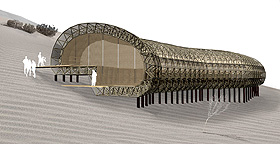Oct 29 2008
A group of UQ students have won an international award for the intuitive design of an emergency bamboo shelter, which could be your saving grace when a natural disaster strikes.
 An emergency bamboo shelter
An emergency bamboo shelter
The UQ team's sustainable structure recently won third place in the student contest organised by the International Association for Shells and Spatial Structures (IASS), for a Light Weight Structure with a Sustainable Approach.
The group of fourth year architecture and civil engineering students used a patented bamboo joint system to create the shelter for a variety of terrains.
The shelter stands about five metres high by 12 metres wide and is engineered to withstand high winds, incorporates rainwater collection and storage systems and is easy and fast to construct, with only five different bamboo member lengths required.
Civil engineering student and team co-ordinator Ryan Cantrill said bamboo was chosen because it was efficient in carrying loads, light weight, used less energy than steel, concrete or timber and had excellent strength and stiffness properties.
“Initially our ideas were focussed on designing a fancy bamboo structure. However, we started researching this material in terms of where it grows naturally, and started to realise that it is native to regions of recent natural disasters,” Mr Cantrill said.
“We wanted something better than a tent, but less permanent and more versatile than a conventional fixed building.
“There were many revisions along the way until we narrowed down exactly what we wanted our structure to be, and what function it had to serve.”
The competition entry was based on UQ Associate Professor Faris Albermani's previous research on bamboo structures, funded by the CRC Sustainable Tourism, with a patented joint system resulting from that project.
“When Associate Professor Albermani and Greg Killen, from engineering firm Arup, both gave it the thumbs up, we knew we were in with a fighting chance,” Mr Cantrill said.
Other UQ group members included architecture students Nicholas Flutter and Marie Penny and civil engineering students Vincent Chan, Elizabeth Knauth and Xavier Khoo.
The students' design will be published in the IASS journal.